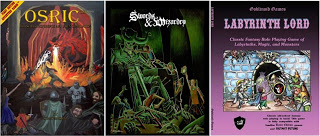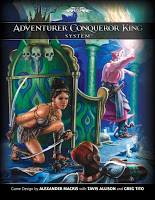There are a few conversations buzzing around Google+ right now about retro-clones and other OSR games. Rather than comment on the particular issues in those conversations, however, I’d like to take a minute and discuss the misuse of the word “clone” in a gaming context.
A clone (aka retro-clone or simulacrum) is a game that emulates the rules of another game. It’s not a statement of style or aesthetics, and it’s not a catch-all for any game produced under the nebulous umbrella of the OSR. A clone tries to recreate the play experience of an earlier game. The differences between the clone and the original are usually organizational, but occasionally a few clean-ups of ambiguous or outrageous rules are introduced which, while making it not a true 100% clone, leave the play of the original intact (especially how the game was actually played back in the day, in many cases) sufficiently to count for all practical purposes.
Examples of true (or fairly true) clones include Labyrinth Lord, Swords & Wizardry, and OSRIC. They don’t rewrite character classes, or change the combat system all around, or replace Vancian magic with a spell-point system, or whatever. They try as closely as possible to emulate D&D or AD&D (other clones could emulate other games, of course).
This leaves us with several entire categories of games that don’t fall into the definition of “clones”, but for which no standard nomenclature has yet been adopted. They include:
- Games based on older games, but which introduce rules changes so significant as to alter the play experience to the point where it is subjectively different from the original.
- Games which have new mechanics but which consciously attempt to emulate the “play feel” of games from the 1970’s and 80’s.
- Games which attempt to create games which where never published or made public in the 1970’s or 80’s, but whose substance can be at least partially intuited or otherwise (re)discovered through research.
Note that I am consciously omitting things which are not stand-alone sets of game rules such as supplements, settings, and adventure modules. In the first category, I’d put games such as Lamentations of the Flame Princess, Myth & Magic, etc. In the second, we have games such as Castles & Crusades, Adventurer Conquerer King, Spellcraft & Swordplay, Barbarians of Lemuria, etc. And in the third category we have Dragons at Dawn and my own Adventures Dark and Deep.
This is a question I’ve been struggling with myself for some time. I’ve seen various suggestions; nostalgia games, neo-clones, etc. but nothing really clicks for me. Here’s my attempt at systematizing the whole thing.
- Retro-clones emulate older game mechanics and feel.
- Retro-builds have an old-school feel, but either use new mechanics or alter the old mechanics to the point where cross-compatibility is difficult. There can be sub-types, but I’m not going to try to get into that level of detail here.











Simulacrum?
I use retro-clone and retro-feel, as in they are going for the feel of OS or a specific OS game. Dungeon World is the least clone like but is trying to get the OS dungeon bashing feel using very dif mechanics.
BTW your first line of describing a clone is incorrect, OSRIC (annoyingly) doesn't include Monk. Or Bard but that is reasonably understandable!
Nuevo-retro? Sounds like something the Jetson's dog would say.
Everybody can quibble about the decisions that a particular clone made, Scott, and is not the point. This is more about finding a suitable terminology for the non-clones.
Celestian: Simulacrum is just another word for clone.
Words shift and change meaning. It is sometimes maddening how the general public with appropriate a word and use it in a way that is the opposite, or tangential meaning. The words geek, ironic, hacker come to mind.
I think it may be an uphill battle to convince the blogosphere and media not to use retroclone as a catch all umbrella for newer games that have some small origin in the older rules.
Perhaps retro-hybrid?
@Random Wizrd: The fact that language evolves should never be used as an excuse not to look for the right term, or to use imprecise language. Evolution, after all, involves the culling of less-fit alternatives, and some species of crab and cephalopods exist which are essentially identical to their ancestors of 100 million years ago.
Yeah, I've always used "Simulacrum" for the games that aren't strictly clones. I use it because "simulacrum" can refer to the play experience while leaving the system out. It can mean "similar," while "clone" means exact.
If that makes sense.
"Games" is a good choice.
Clone is common vernacular now. It's a bit late to redefine it. Also, only a nerd would come up with simulacrum as a substitute. ;P
Retro-mod? Neo-clone?
Whatever you want to call them, I agree completely. And it's not sufficient/applicable to call those games you mentioned "second wave" retroclones.
I vote we don't worry about it.
It's retro; it's a game. Retro-game.
Fantasy Role-Playing Game pretty much covers them doesn't it?
Hate to sound negative but the OSR is not the originator of innovation in game design that certain people believe them to be. Since D&D first hit the shelves people have been coming up with and publishing their own variations on what an rpg can be or what they believe they should be. Look at Runequest, T&T, the Rolemaster products, Arduin, etc.
Guess what – all Fantasy RPGs.
Deciding that your "clone" needs a special term is silly, but if you need one how about…
Derivative Fantasy RPG
I'm with Dan and Chad, "clone" is pretty well universal and accepted. Most folks know it's a broad category. So yep, why worry about it? 🙂
@Degenerate Elite: a key feature of the clones/simulacra/derivatives is that, despite whatever tweaks/additions, they are are compatible with TSR-era D&D and each other. Which isn't true for RuneQuest or Rolemaster. In this case, the fact that these games are derivative and are innovative only in very limited ways is a virtue.
@Joseph Bloch:
Actually no, the Gray Elf is right, since clone and simulacrum are two words having very different meaning.
I can see that you don't mind the difference, but a clone is a copy as perfect as possible having the same genetic material, while a simulacrum is an image or a representation of something else, often with an artistic intent. In latin simulacrum means statue.
So, by virtue of this difference, OSRIC, LL and S&W are clones, while DCC, Mazes & Minotaurs, Astonishing Swordsmen & Sorcerers of Hyperborea, Lamentations of the Flame Princess, are simulacra.
And Dungeon World is a cubist simulacrum…
It still wouldn't apply, Paride, since what you're referring to as simulacra, and I refer to as retro-builds, aren't attempting to be an image or representation of something else, but rather something new that uses an older game as a foundation.
A statue of Napoleon with four arms and the head of a gorilla is no longer attempting to represent Napoleon, even if it originally used his body as inspiration.
Is this abstract painting still Napoleon?
http://www.liveauctioneers.com/item/3322548
You can classifying strictly in retro-clones or retro-builds on the basis of the quantity of the rules mantained unchanged, but this classification OSR games allows only for games strongly mechanically related to D&D/AD&D.
There is not much place left for interpretation and recreation (rulewise). Is that your view?